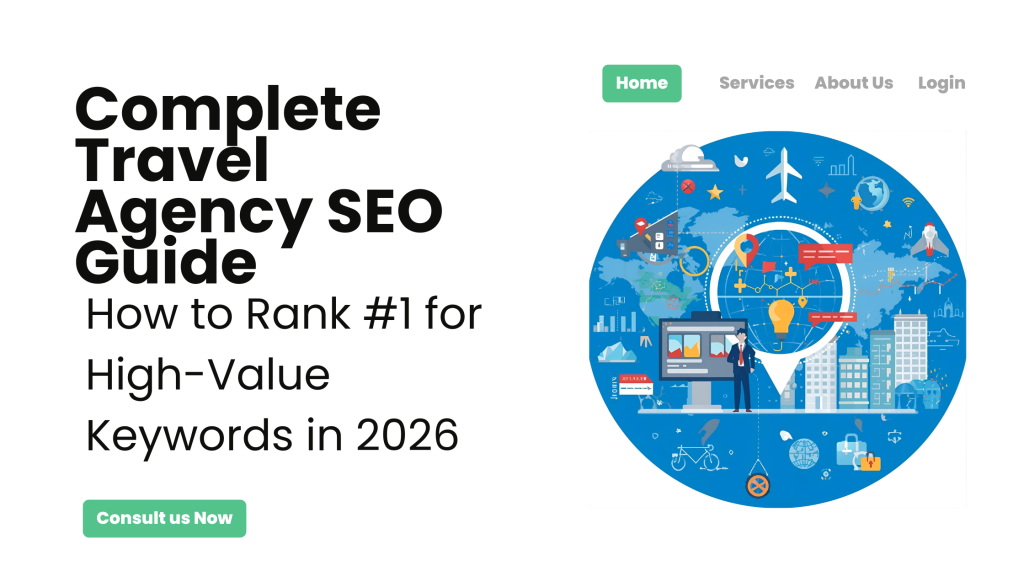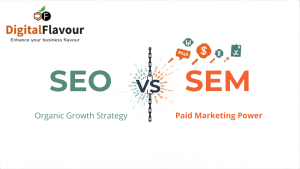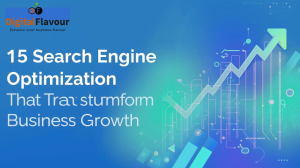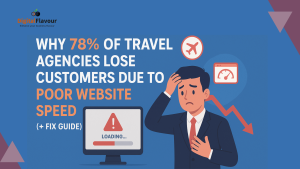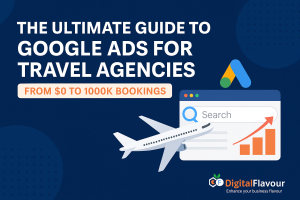Last Updated: September 2025 | Reading Time: 18 minutes
The travel industry is experiencing unprecedented digital transformation. With 83% of travelers starting their journey with online research and Google processing over 8.5 billion travel-related searches monthly, having a robust SEO strategy isn’t optional—it’s survival.
This comprehensive travel agency SEO guide will show you exactly how to outrank competitors, capture high-intent travelers, and convert searches into bookings. Whether you’re a boutique travel agency or a growing tour operator, these proven strategies by Digital Flavour, Best Digital Marketing Agency will help you dominate search results in 2026.
Table of Contents
ToggleWhy Travel Agency SEO is Critical in 2026 {#why-travel-agency-seo-is-critical}
The Digital Travel Landscape
The statistics tell a compelling story:
- 94% of travelers use digital channels to research and book trips
- Google controls 92% of travel-related search traffic
- Organic search drives 40% of travel website revenue
- First page rankings capture 75% of all clicks
- 57% of travel bookings start with a mobile search
The Competition Reality Check
Travel SEO faces unique challenges that make ranking harder than ever:
1. OTA Domination: Booking.com, Expedia, and Airbnb occupy 60% of top travel search results
2. High Competition: Travel keywords average 70+ difficulty scores
3. Seasonal Fluctuations: Search volumes can vary 300% between peak and off-seasons
4. Complex User Intent: Travelers research for months before booking
Despite these challenges, independent travel agencies that master SEO or work with experienced agency for SEO Services see:
- 250% increase in organic traffic within 12 months
- 180% improvement in lead quality
- $15 return for every $1 invested in SEO
Travel Industry SEO Challenges {#travel-industry-challenges}
Understanding these unique challenges is crucial for developing an effective strategy:
Challenge #1: Inventory Management & Dynamic URLs
Travel websites often have thousands of dynamic pages for different destinations, dates, and packages. This creates:
- Duplicate content issues across similar itineraries
- Crawl budget waste on low-value pages
- Index bloat that dilutes page authority
Solution: Implement proper URL structure with canonical tags and strategic no-indexing of low-value pages.
Challenge #2: Seasonal Search Patterns
Travel demand fluctuates dramatically:
- Summer destinations see 400% search volume increase May-August
- Winter sports keywords peak November-February
- Holiday travel spikes create intense competition windows
Solution: Create content calendars aligned with seasonal trends and optimize for shoulder seasons when competition is lower.
Challenge #3: Multi-Intent Keywords
A single search like “Paris vacation” could mean:
- Researching destinations
- Comparing packages
- Ready to book
- Looking for travel tips
Solution: Map content to specific search intent stages and create topic clusters around destinations.
High-Value Keywords Research Strategy {#keyword-research-strategy}
Understanding Travel Search Intent
Travel searches follow a predictable pattern:
1. Inspiration Phase (6-12 months before travel)
- “best destinations 2026”
- “romantic getaway ideas”
- “family vacation spots”
2. Research Phase (3-6 months before travel)
- “things to do in [destination]”
- “[destination] travel guide”
- “best time to visit [destination]”
3. Booking Phase (1-3 months before travel)
- “[destination] vacation packages”
- “[destination] travel agency”
- “book [destination] tour”
High-Value Keyword Categories
Destination-Specific Keywords (High Volume, High Competition)
- “[Destination] vacation packages” – 8,100 monthly searches
- “[Destination] tours” – 6,600 monthly searches
- “[Destination] travel guide” – 4,400 monthly searches
- “best time to visit [destination]” – 3,600 monthly searches
Service-Based Keywords (Medium Volume, Lower Competition)
- “custom travel planning” – 1,900 monthly searches
- “group travel packages” – 1,600 monthly searches
- “luxury travel agent” – 1,300 monthly searches
- “corporate travel services” – 1,100 monthly searches
Long-tail Opportunity Keywords (Lower Volume, High Conversion)
- “all inclusive [destination] packages” – 880 monthly searches
- “[destination] honeymoon packages” – 720 monthly searches
- “family friendly [destination] tours” – 590 monthly searches
- “budget [destination] travel packages” – 480 monthly searches
Advanced Keyword Research Techniques
1. Competitor Gap Analysis
Identify keywords your competitors rank for that you don’t:
Tools: Ahrefs, SEMrush, or SpyFu
Process:
- Enter 3-5 competitor URLs
- Export their ranking keywords
- Filter by position 1-10
- Cross-reference with your rankings
- Prioritize gaps with high search volume
2. Question-Based Keywords
Travelers ask 2.4 billion questions monthly about travel. Target these with dedicated FAQ pages:
- “How much does a [destination] trip cost?”
- “What documents do I need for [destination]?”
- “Is [destination] safe for solo travelers?”
3. Local + Travel Combinations
Combine your location with travel services:
- “[Your City] travel agency”
- “Travel agent near me”
- “[Your City] vacation packages”
Technical SEO Foundation {#technical-seo-foundation}
Technical SEO is the foundation of travel website success. Here’s your step-by-step implementation guide:
Site Architecture for Travel Websites
Optimal URL Structure
✅ Good: yoursite.com/destinations/italy/rome-vacation-packages
❌ Bad: yoursite.com/packages?dest=IT&city=ROM&type=vacation
Best Practices:
- Use descriptive, keyword-rich URLs
- Keep URLs under 60 characters
- Include primary keyword in URL
- Use hyphens to separate words
- Implement consistent structure across all pages
Internal Linking Strategy
Create logical content hierarchies:
Homepage
├── Destinations
│ ├── Europe
│ │ ├── Italy
│ │ │ ├── Rome Tours
│ │ │ ├── Florence Packages
│ │ │ └── Venice Travel Guide
│ │ └── France
│ └── Asia
└── Travel Services
├── Group Travel
├── Corporate Travel
└── Luxury Travel
Page Speed Optimization
Site speed directly impacts rankings and conversions. Travel sites average 4.2 seconds load time, but optimal performance requires under 2 seconds.
Critical Optimizations:
1. Image Compression
- Use WebP format (30% smaller than JPEG)
- Implement lazy loading for destination galleries
- Compress images to under 100KB without quality loss
- Use responsive images with srcset attributes
2. Caching Strategy
- Enable browser caching (1 year for static assets)
- Implement CDN for global content delivery
- Use page caching for destination pages
- Cache API calls for package pricing
3. Code Optimization
- Minify CSS, JavaScript, and HTML
- Remove unused code and plugins
- Combine CSS files to reduce HTTP requests
- Use async loading for non-critical JavaScript
Schema Markup for Travel
Schema markup helps search engines understand your travel content better. Implement these travel-specific schemas:
Organization Schema
{
"@context": "https://schema.org",
"@type": "TravelAgency",
"name": "Your Travel Agency",
"url": "https://yourtravelagency.com",
"address": {
"@type": "PostalAddress",
"streetAddress": "123 Travel Street",
"addressLocality": "Your City",
"postalCode": "12345",
"addressCountry": "US"
},
"telephone": "+1-555-123-4567",
"openingHours": "Mo,Tu,We,Th,Fr 09:00-17:00"
}
Trip Schema for Packages
{
"@context": "https://schema.org",
"@type": "Trip",
"name": "7-Day Italy Adventure",
"description": "Explore Rome, Florence, and Venice...",
"offers": {
"@type": "Offer",
"price": "2499",
"priceCurrency": "USD",
"availability": "https://schema.org/InStock"
},
"itinerary": [
{
"@type": "TouristTrip",
"name": "Rome City Tour",
"description": "Explore the Colosseum and Vatican..."
}
]
}
Content Strategy for Travel Agencies {#content-strategy}
Content is the engine that drives travel SEO success. Here’s how to create content that ranks and converts:
Content Types That Drive Rankings
1. Comprehensive Destination Guides (2,500+ words)
Create in-depth guides that answer all traveler questions:
Template Structure:
- Introduction (destination overview)
- Best time to visit
- Top attractions and activities
- Where to stay (by budget level)
- Local cuisine and dining
- Transportation options
- Cultural tips and customs
- Sample itineraries (3, 7, 14 days)
- Budget planning
- Safety and health information
- FAQ section
SEO Optimization:
- Target primary keyword in title, H1, and first paragraph
- Use related keywords in subheadings (H2, H3)
- Include 10-15 relevant keywords naturally throughout
- Add location-based keywords for local SEO
- Include internal links to related content and packages
2. Travel Itinerary Content
Pre-built itineraries rank well and showcase your expertise:
High-Performing Formats:
- “Perfect 7-Day Italy Itinerary: Rome, Florence & Venice”
- “Ultimate 2-Week Southeast Asia Adventure”
- “Romantic 5-Day Paris Itinerary for Couples”
Conversion Elements:
- Detailed daily schedules
- Accommodation recommendations by budget
- Transportation between cities
- Cost breakdowns
- “Book This Trip” CTAs throughout
- Customization options
3. Seasonal Travel Content
Capitalize on seasonal search trends:
Q4 Content (October-December):
- Holiday travel guides
- New Year’s Eve destinations
- Winter vacation ideas
- Christmas market tours
Q1 Content (January-March):
- Spring break destinations
- Easter holiday packages
- Cherry blossom travel guides
- Warm weather escapes
Content Optimization Best Practices
Keyword Optimization Without Keyword Stuffing
- Primary keyword density: 0.5-1.5% of total word count
- LSI keywords: Include 5-10 semantically related terms
- Natural usage: Keywords should flow naturally in sentences
- Keyword variations: Use synonyms and related phrases
User Experience Signals
Google measures user engagement signals that impact rankings:
Optimize for:
- Time on page: Create engaging content that keeps users reading
- Bounce rate: Internal linking and related content suggestions
- Page depth: Encourage users to visit multiple pages
- Return visits: Email capture for content updates
Visual Content Strategy
Travel is a visual industry. Optimize images for both user experience and SEO:
Image SEO Checklist:
- Descriptive file names with keywords
- Alt text describing the image and location
- Captions with relevant keywords
- Image sitemaps for better indexing
- Geo-tagging for location relevance
Local SEO for Travel Businesses {#local-seo}
Local SEO helps travel agencies capture “near me” searches and establish local authority.
Google Business Profile Optimization
Your Google Business Profile is critical for local visibility:
Complete Profile Setup
- Business name: Use official name (avoid keyword stuffing)
- Category: Select “Travel Agency” as primary category
- Address: Use consistent NAP (Name, Address, Phone) across web
- Hours: Keep updated, including holiday hours
- Phone: Use local number, not toll-free
- Website: Link to homepage or location-specific page
Content Strategy for GBP
- Posts: Share travel tips, destination highlights, package deals
- Photos: Upload high-quality images of destinations and office
- Q&A: Proactively answer common travel questions
- Reviews: Respond to all reviews professionally and promptly
Local Citation Building
Build consistent citations across travel and local directories:
High-Authority Travel Directories:
- TripAdvisor Business Listings
- Yelp for Businesses
- Travel Weekly Directory
- ASTA (American Society of Travel Advisors)
- Local Chamber of Commerce
Citation Consistency Rules:
- Exact same business name across all platforms
- Consistent address format
- Same phone number everywhere
- Matching website URL
Local Content Strategy
Create content that establishes local expertise:
Location-Based Content Ideas:
- “Best [Your City] Travel Agency: Why Choose Local”
- “[Your City] to [Destination]: Complete Travel Guide”
- “Local Travel Expert’s Guide to [Popular Destination]”
- “[Your City] Residents’ Favorite Vacation Destinations”
Link Building for Travel Websites {#link-building}
Quality backlinks remain one of the most important ranking factors for travel SEO. Here’s how to build authority through strategic link building:
Travel Industry Link Opportunities
1. Destination Marketing Organizations (DMOs)
Partner with tourism boards for mutual benefits:
- Strategy: Offer to write destination guides in exchange for backlinks
- Value Exchange: Your content marketing their destination
- Link Types: Resource pages, partner directories, featured articles
2. Travel Blogger Collaborations
Travel bloggers need expertise; you need exposure:
- Guest posting: Write detailed guides for established travel blogs
- Expert quotes: Provide insights for blogger articles
- Trip sponsorships: Sponsor blogger trips in exchange for coverage
- Resource creation: Create downloadable guides bloggers can share
3. Local Business Partnerships
Build community connections:
- Hotel partnerships: Cross-promotional content and links
- Restaurant recommendations: Local dining guides with reciprocal links
- Activity providers: Partner with local tour companies
- Professional services: Accountants, lawyers, other local businesses
Content-Driven Link Building Strategies
1. Research and Data Studies
Create linkable assets that media will reference:
Examples:
- “Travel Trends 2026: Survey of 10,000 Travelers”
- “Most Affordable European Destinations Analysis”
- “Impact of Currency Changes on Travel Costs”
2. Ultimate Resource Guides
Comprehensive guides earn natural backlinks:
- “Complete Guide to [Destination] Visa Requirements”
- “Ultimate Packing Checklist for Every Trip Type”
- “Travel Photography Guide: From Beginner to Pro”
3. Interactive Tools and Calculators
Tools provide ongoing value and earn consistent links:
- Trip budget calculator
- Best time to visit finder
- Currency converter
- Travel quiz: “What’s your ideal destination?”
Outreach Strategy
Email Templates That Get Results
Guest Post Pitch:
Subject: Travel Expert Content for [Blog Name] Readers
Hi [Name],
I'm [Your Name] from [Travel Agency], and I've been following your excellent content on [specific post/topic].
I noticed you recently covered [related topic]. I'd love to contribute a comprehensive guide on [specific topic] that would provide immense value to your audience.
I can offer:
- 2,500+ word in-depth guide
- Original research and insights
- Professional destination photography
- Expert itinerary recommendations
Would this type of content be valuable for your readers?
Best regards,
[Your Name]
Resource Page Outreach:
Subject: Quality Resource for Your [Topic] Page
Hi [Name],
I found your excellent resource page about [topic] at [URL].
I recently published a comprehensive guide that would be a valuable addition to your resources: [Your Content URL]
The guide covers [brief description] and has already been referenced by [credible source].
Would you consider adding it to your resource collection?
Thanks for curating such helpful content!
Best,
[Your Name]
Mobile-First Optimization {#mobile-optimization}
With 73% of travel searches happening on mobile devices, mobile optimization isn’t optional—it’s critical for success.
Mobile User Experience Essentials
Navigation Design
- Hamburger menu: Clean, easy-to-access navigation
- Search functionality: Prominent search bar on homepage
- Quick filters: Easy filtering for destinations and dates
- One-thumb operation: Buttons sized for easy tapping
Booking Process Optimization
- Guest checkout: Don’t force account creation
- Auto-fill capabilities: Support address and payment auto-fill
- Progress indicators: Show booking steps clearly
- Error handling: Clear, helpful error messages
Page Speed for Mobile
Mobile users are even less patient than desktop users:
- Target speed: Under 3 seconds on 3G connection
- Critical optimizations: Compress images, minimize code
- AMP implementation: Consider AMP for blog content
- Progressive loading: Load critical content first
Mobile-Specific SEO Factors
Core Web Vitals Optimization
Google’s Core Web Vitals directly impact mobile rankings:
Largest Contentful Paint (LCP)
- Target: Under 2.5 seconds
- Optimization: Optimize hero images, use CDN
First Input Delay (FID)
- Target: Under 100 milliseconds
- Optimization: Minimize JavaScript execution time
Cumulative Layout Shift (CLS)
- Target: Under 0.1
- Optimization: Set image dimensions, avoid pop-ups
Measuring SEO Success {#measuring-success}
Track the right metrics to optimize your travel SEO strategy:
Key Performance Indicators (KPIs)
Organic Traffic Metrics
- Overall organic traffic growth: Month-over-month increase
- Branded vs. non-branded traffic: Balance of brand and keyword traffic
- Mobile vs. desktop traffic: Mobile traffic percentage
- Geographic traffic distribution: Traffic by target markets
Ranking Metrics
- Keyword position tracking: Monitor 50+ target keywords
- Feature snippet captures: Rich snippets and featured snippets
- Local pack appearances: Local search visibility
- Image search rankings: Destination photo visibility
Conversion Metrics
- Organic conversion rate: Percentage of organic traffic that converts
- Revenue attribution: Revenue directly from organic search
- Lead quality scores: Qualification rate of organic leads
- Cost per acquisition: Compare organic vs. paid acquisition costs
Essential SEO Tools for Travel Agencies
Free Tools
- Google Search Console: Technical issues, ranking data, click-through rates
- Google Analytics 4: Traffic analysis, conversion tracking, user behavior
- Google Business Profile: Local SEO performance, review management
- Google Trends: Seasonal keyword trends, destination popularity
Premium Tools ($100-$400/month)
- Ahrefs or SEMrush: Comprehensive keyword research, competitor analysis
- Screaming Frog: Technical SEO auditing, crawl analysis
- BrightLocal: Local SEO tracking, citation management
- Hotjar: User behavior analysis, conversion optimization
Monthly SEO Reporting Template
Create consistent reports to track progress:
Executive Summary
- Key achievements this month
- Traffic and conversion highlights
- Major ranking improvements
- Issues identified and resolved
Traffic Analysis
- Organic traffic growth (% change)
- Top performing pages
- New keyword rankings
- Mobile vs. desktop performance
Technical Health Check
- Site speed improvements
- Core Web Vitals scores
- Indexing issues resolved
- Schema markup additions
Content Performance
- New content published
- Top performing blog posts
- Social shares and engagement
- Internal linking improvements
Advanced SEO Tactics {#advanced-tactics}
Take your travel SEO to the next level with these advanced strategies:
Topic Clusters and Pillar Pages
Content Hub Strategy
Create comprehensive content hubs around major destinations:
Pillar Page: “Complete Guide to Italy Travel” Cluster Pages:
- Rome travel guide
- Florence attractions
- Venice gondola tours
- Tuscany wine tours
- Italian food and cuisine
- Italy travel costs
- Best time to visit Italy
Linking Strategy: All cluster pages link to the pillar page, and the pillar page links to all cluster content.
International SEO for Travel
Hreflang Implementation
If you serve multiple countries or languages:
<link rel="alternate" hreflang="en-us" href="https://example.com/us/" />
<link rel="alternate" hreflang="en-ca" href="https://example.com/ca/" />
<link rel="alternate" hreflang="es-mx" href="https://example.com/mx/" />
Geotargeting Strategy
- Country-specific domains: .co.uk for UK, .com.au for Australia
- Subdirectories: yoursite.com/uk/, yoursite.com/au/
- Currency and language: Display appropriate currency and language
- Local contact information: Phone numbers and addresses for each market
Voice Search Optimization
Conversational Keyword Targeting
Optimize for how people actually speak:
- Traditional: “best time visit Japan”
- Voice search: “when is the best time to visit Japan”
FAQ Schema Implementation
Structure FAQ content for voice search:
{
"@context": "https://schema.org",
"@type": "FAQPage",
"mainEntity": [{
"@type": "Question",
"name": "What is the best time to visit Japan?",
"acceptedAnswer": {
"@type": "Answer",
"text": "The best time to visit Japan is during spring (March-May) or autumn (September-November) when weather is mild and you can see cherry blossoms or fall foliage."
}
}]
}
Video SEO for Travel Content
YouTube Optimization
Create destination videos that rank on both YouTube and Google:
- Video titles: Include target keywords naturally
- Descriptions: Detailed descriptions with links to your website
- Tags: Use relevant travel and destination tags
- Transcripts: Upload accurate transcripts for accessibility
- Thumbnails: Eye-catching custom thumbnails
Video Schema Markup
Help search engines understand your video content:
{
"@context": "https://schema.org",
"@type": "VideoObject",
"name": "Ultimate Guide to Tokyo in 5 Days",
"description": "Complete 5-day Tokyo itinerary...",
"thumbnailUrl": "https://example.com/tokyo-video-thumbnail.jpg",
"uploadDate": "2025-09-15",
"duration": "PT10M30S"
}
Conclusion: Your SEO Success Roadmap
Implementing this complete travel agency SEO guide will transform your online visibility and booking conversions. Here’s your 90-day action plan:
Days 1-30: Foundation Building
- [ ] Complete technical SEO audit and fix critical issues
- [ ] Optimize Google Business Profile
- [ ] Conduct comprehensive keyword research
- [ ] Set up tracking tools (Analytics, Search Console)
- [ ] Create content calendar for next quarter
Days 31-60: Content and Optimization
- [ ] Publish 4-6 comprehensive destination guides
- [ ] Optimize existing pages for target keywords
- [ ] Build initial local citations
- [ ] Launch first link building campaigns
- [ ] Implement schema markup on key pages
Days 61-90: Scale and Measure
- [ ] Analyze performance data and adjust strategy
- [ ] Expand content production to 2-3 posts per week
- [ ] Advanced link building and partnerships
- [ ] Mobile optimization improvements
- [ ] Plan advanced tactics implementation
Long-term Success Factors
Consistency: SEO is a marathon, not a sprint. Consistent effort over 6-12 months delivers exponential results.
User Focus: Always prioritize user experience over search engines. Google rewards sites that satisfy user intent.
Adaptation: The travel industry and SEO both evolve rapidly. Stay current with trends and algorithm updates.
Measurement: Track progress monthly and adjust tactics based on data, not assumptions.
Remember: Travel SEO isn’t just about rankings—it’s about connecting dream destinations with eager travelers. Focus on creating genuine value, and the rankings will follow.
Ready to dominate travel search results?
Start with a comprehensive SEO audit of your current website. Identify your biggest opportunities and quick wins that can deliver results in the next 30 days.
Need personalized help implementing these strategies? Our travel marketing experts have helped 200+ travel agencies achieve first-page rankings. Schedule a free SEO consultation to discuss your specific goals and challenges.
This guide is updated regularly to reflect the latest SEO best practices and algorithm changes. Bookmark this page and check back quarterly for updates.
Author
-
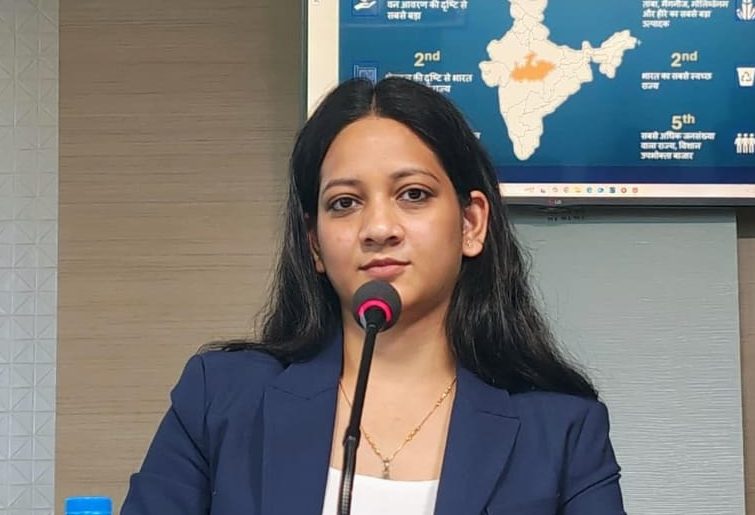
Ragini Neema is the founder & CEO of Digital Flavour, Indore’s leading digital marketing agency helping startups and businesses scale into powerful brands. With expertise in SEO, Social media marketing, paid advertising, and Web development, has positioned Digital Flavour as a trusted growth partner for companies that aim to go big. Recognized as a digital marketing expert, Ragini blends strategy, creativity, and innovation to deliver measurable results in today’s competitive online world.

